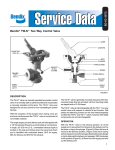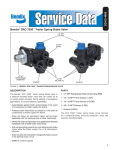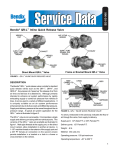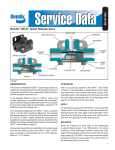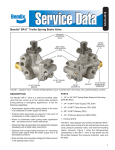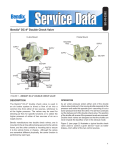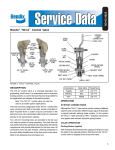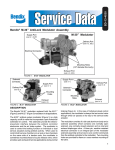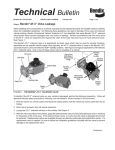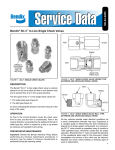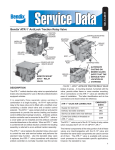Download BENDIX BW1786 User's Manual
Transcript
SD-03-907 ® Bendix® QRN-2™ Quick Release Valve 1.50" SUPPLY SUPPLY PIECE NUMBER, DATE CODE, AND T.M.C. IDENTIFICATIONS STAMPED HERE DELIVERY DELIVERY BODY BODY EXHAUST COVER DELIVERY EXHAUST FIGURE 1 - QRN-2™ QUICK RELEASE VALVE Supply port: 1/2"-14 P.T. or 3/8"-18 P.T. DESCRIPTION The Bendix® QRN-2™ quick release valve is a lightweight, nonmetallic quick release valve. It is designed to “speed up” the release of air from the devices it is attached to. In its standard configuration the valve is designed to deliver within 1 psi of control pressure. However, for special applications the valve is available with zero hysteresis. Delivery ports: 3/8"-18 P.T. Weight: .3 lb. Material: Molded black reinforced nylon 6 Operating pressure: 150 psi maximum Operating temperature: -40° to 180° F Port Embossed I.D. Supply SUP 1 Delivery DEL 2 Exhaust EXH 3 FRONT AXLE BRAKE CHAMBER DELIVERY SUPPLY QRN-2™ VALVE DUAL BRAKE VALVE DIAPHRAGM DELIVERY SUPPLY BRAKE VALVE SECONDARY CIRCUIT DELIVERY DELIVERY DELIVERY EXHAUST FIGURE 2 - QRN-2™ QUICK RELEASE VALVE SECTIONAL VIEW SUPPLY RESERVOIR SECONDARY CIRCUIT RESERVOIR FIGURE 3 - PARTIAL SYSTEM SCHEMATIC WITH QRN-2™ QUICK RELEASE VALVE SUPPLY SUPPLY DIAPHRAGM DELIVERY DELIVERY DELIVERY DELIVERY DIAPHRAGM EXHAUST EXHAUST FIGURE 4 - QRN-2™ QUICK RELEASE VALVE APPLY FIGURE 6 - QRN-2™ QUICK RELEASE VALVE RELEASE Figure 1 shows the QRN-2™ valve with its port designations, date code, piece number and T.M.C. identifications. Figure 2 is a sectional view. Note that the standard QRN-2™ valve, which has a 1 psi maximum differential, does not include a differential spring. Figure 3 shows a partial air brake system schematic with a QRN-2™ valve. Receiving its signal from the secondary brake circuit, the QRN-2™ valve is controlling the front axle brake chambers. BALANCE Figure 5 shows the QRN-2™ valve balanced mode. When air pressure beneath diaphragm is approximately 1 psi less than air pressure above the diaphragm, the outer edges of the diaphragm seal against the body’s sealing lip. The exhaust remains sealed because air pressure bears against the center portion of the diaphragm from one side only. RELEASE OPERATION APPLY As shown in Figure 4, when air pressure enters the supply port, it causes the center portion of the diaphragm to seal the exhaust. Supply air pressure simultaneously forces the edges of the diaphragm away from the sealing lip in the body, allowing air to flow out the delivery ports. Delivery pressure will be within 1 psi of supply pressure for the standard QRN-2™ valve. When air pressure is removed from the QRN-2™ valve supply port, the air pressure on the delivery side of the diaphragm holds the outer edge of the diaphragm against the sealing lip in the body while simultaneously moving the center portion away from the exhaust port. Air from the delivery ports flows out the exhaust. When delivery air pressure is fully exhausted, the diaphragm will return to its natural state, with its outer edges sealing the delivery and its center portion sealing the exhaust. WARNING! PLEASE READ AND FOLLOW THESE INSTRUCTIONS TO AVOID PERSONAL INJURY OR DEATH: When working on or around a vehicle, the following general precautions should be observed at all times. SUPPLY DELIVERY SEALED DIAPHRAGM DELIVERY DELIVERY EXHAUST SEALED EXHAUST FIGURE 5 - QRN-2™ QUICK RELEASE VALVE BALANCE 1. Park the vehicle on a level surface, apply the parking brakes, and always block the wheels. Always wear safety glasses. 2. Stop the engine and remove ignition key when working under or around the vehicle. When working in the engine compartment, the engine should be shut off and the ignition key should be removed. Where circumstances require that the engine be in operation, EXTREME CAUTION should be used to prevent personal injury resulting from contact with moving, rotating, leaking, heated or electrically charged components. 3. Do not attempt to install, remove, disassemble or assemble a component until you have read and thoroughly understand the recommended procedures. Use only the proper tools and observe all precautions pertaining to use of those tools. 4. If the work is being performed on the vehicle’s air brake system, or any auxiliary pressurized air systems, make certain to drain the air pressure from all reservoirs before beginning ANY work on the vehicle. If the vehicle is equipped with an AD-IS™ air dryer system or a dryer reservoir module, be sure to drain the purge reservoir. 5. Following the vehicle manufacturer’s recommended procedures, deactivate the electrical system in a manner that safely removes all electrical power from the vehicle. 6. Never exceed manufacturer’s recommended pressures. 7. Never connect or disconnect a hose or line containing pressure; it may whip. Never remove a component or plug unless you are certain all system pressure has been depleted. 8. Use only genuine Bendix ® replacement parts, components and kits. Replacement hardware, tubing, hose, fittings, etc. must be of equivalent size, type and strength as original equipment and be designed specifically for such applications and systems. 9. Components with stripped threads or damaged parts should be replaced rather than repaired. Do not attempt repairs requiring machining or welding unless specifically stated and approved by the vehicle and component manufacturer. 10. Prior to returning the vehicle to service, make certain all components and systems are restored to their proper operating condition. SERVICE CHECKS PREVENTIVE MAINTENANCE 2. Remove the QRN-2™ valve from the vehicle. Retain the mounting hardware. Important: Review the Bendix Warranty Policy before performing any intrusive maintenance procedures. A warranty may be voided if intrusive maintenance is performed during the warranty period. No two vehicles operate under identical conditions, as a result, maintenance intervals may vary. Experience is a valuable guide in determining the best maintenance interval for air brake system components. At a minimum, the QRN-2™ valve should be inspected every 12 months or 3600 operating hours, whichever comes first, for proper operation. Should the QRN-2™ valve not meet the elements of the operational tests noted in this document, further investigation and service of the valve may be required. 1. Remove any accumulated contaminants. Visually inspect the valve’s exterior for cracks, gouges, or other physical damage. Replace the valve if physical damage is excessive. 2. Inspect all air lines connected to the valve for signs of wear or physical damage. Repair/replace as necessary. 3. Test air line fittings for excessive leakage and tighten or replace as necessary. OPERATIONAL AND LEAKAGE TESTS 1. Block the vehicle’s wheels and fully charge the air system. 2. Apply and release the service brakes several times and check for prompt response of the brakes at the appropriate wheels. 3. With the air system fully charged, apply a soap solution to the QRN-2™ valve exhaust port. Leakage of a 1" bubble in 5 seconds is permissible. 4. Make and hold a full brake application and again apply a soap solution to the QRN-2™ valve exhaust. Leakage of a 1" bubble in 3 seconds is permissible. 5. With the brakes still applied, apply a soap solution around the valve where the exhaust cover meets the body. No leakage at this point is permitted. If the valve does not function as described, or if leakage is excessive, replace it at any authorized parts outlet. REMOVAL 1. Identify and mark or label all air lines and their connections to the QRN-2™ valve. Then disconnect the air lines. INSTALLATION 1. Install the QRN-2™ valve on the vehicle using the mounting hardware saved during removal. 2. Reconnect all air lines to the valve using the identification made during removal. 3. Test all air fittings for excessive leakage and tighten as needed. NOTE: MAXIMUM TORQUE FOR FITTINGS IS 10 FT. LBS. Perform OPERATIONAL AND LEAKAGE TESTS before placing the vehicle back into service. NOTE: THERE ARE NO DISASSEMBLY/ASSEMBLY PROCEDURES FOR THE QRN-2™ VALVE. IT IS A REPLACE ITEM. IF A VALVE DOES NOT MEET THE OPERATIONAL AND LEAKAGE TESTS, IT SHOULD BE REPLACED AT ANY AUTHORIZED PARTS OUTLET. BW1786 © 2004 Bendix Commercial Vehicle Systems LLC All rights reserved. 3/2004 Printed in U.S.A.




